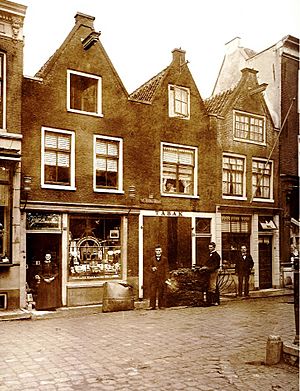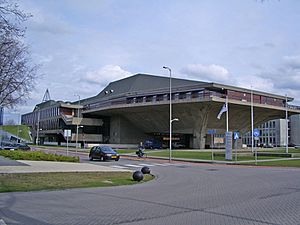Frederik H. Kreuger facts for kids
Quick facts for kids
Frederik H. Kreuger
|
|
|---|---|

Frederik H. Kreuger
|
|
| Born | 14 May 1928 Amsterdam, Netherlands
|
| Died | 10 January 2015 (aged 86) Delft, Netherlands
|
| Nationality | Dutch |
Frederik Hendrik Kreuger (born May 14, 1928 – died January 10, 2015) was a smart Dutch scientist and inventor. He was an expert in high voltage electricity. He also taught as a professor at the Delft University of Technology in the Netherlands. Besides his science work, he wrote many books. These included technical guides, non-fiction stories, thrillers, and a detailed book about the famous art forger, Han van Meegeren.
Contents
Early Life and Education
Frederik H. Kreuger came from an old family in Amsterdam. His grandfather owned a tobacco factory there. Kreuger even wrote a book about his grandfather. This book also talked about how science grew rapidly during that time, called the Belle Époque.
He went to school in Haarlem. He studied engineering at the Delft University of Technology. In 1961, he earned his Ph.D. degree there.
A Career in High Voltage Science
Kreuger worked as a high voltage scientist in Sweden, England, and the Netherlands. In the Netherlands, he worked for the electrical industry. Later, he became the managing director of a company called Nederlandse Kabelfabriek in Delft.
In 1986, he became a high voltage professor at his old university in Delft. He taught there until 1995. His high voltage lab in Delft became a key place for studying partial discharges. It also became important for learning about Direct current high voltage.
Amazing Inventions and Discoveries
Kreuger invented several important things for high voltage cable systems. He also created equipment to find partial discharges. Some of his inventions include:
- A way to balance the detection of partial discharges. This is sometimes called the Kreuger bridge.
- A standard for measuring partial discharges.
- The elastomeric joints now commonly used in solid high voltage cables. These are also known as bi-manchet.
- The elastomeric terminals now commonly used for solid high voltage cables.
His book, Partial Discharge Detection, was a leading textbook for 25 years. He also wrote books about managing research and the downsides of wind energy.
Harnessing Solar Power from the Sea
Kreuger also invented a way to get solar power from the sea. This system uses large floating fields of algea. These algae would produce biofuel. This project is managed by the Botanical Garden at the Delft University of Technology. Many parts of the university are working together on it.
Exploring Art and History
Kreuger was very interested in art and history. He studied the famous Dutch painter Johannes Vermeer. He looked into how Vermeer might have used a Camera obscura for his paintings. He also studied where Vermeer might have painted his famous work, Little Street. An English version of this study is kept in the Delft city archives.
Uncovering the Truth About a Master Forger
In 2001, Kreuger began studying the life of the famous Dutch art forger, Han van Meegeren. His first book about Van Meegeren was a novel. It was later translated into English as "The Deception." This book also included some stories about Vermeer's life.
Kreuger was in a good position to write about Van Meegeren. He spoke Dutch, Van Meegeren's native language. He also lived in the Netherlands when Van Meegeren was active. He looked for original sources, especially in the Netherlands. He added new information to what others had found before him.
Kreuger was lucky enough to meet Van Meegeren's last living relatives. He also met the last person who saw Van Meegeren arrested. He found a book written by Van Meegeren's son, Jacques, that had new details about the artist's life. He also found unknown photos related to Van Meegeren.
He also found paintings Van Meegeren made under his own name. He identified more fake Old Master paintings made by Van Meegeren.
In 2004, he shared his findings in a Dutch book called Han van Meegeren, Meestervervalser. This book gathered new facts and newly found works by Van Meegeren. In 2006, he published another Dutch book, De Arrestatie van een Meestervervalser. This book included many reactions to his first biography.
His English book, A New Vermeer. Life and Work of Han van Meegeren, came out in 2007. The title came from a famous article. In that article, a great art expert praised a Van Meegeren fake painting as the best Vermeer ever seen. In this book, Kreuger also wrote about Van Meegeren's son, Jacques. He found out that Jacques had also copied his father's work.
A Passion for Music
Kreuger was also a talented musician. He played the leading violin in an amateur gipsy orchestra called Siperkov Ensemble. He studied Gipsy or Romani music. He wrote a Dutch book about the history and meaning of Gipsy music. A part of this book became an article on the Dutch Wikipedia about "Zigeunermuziek".
Legacy
Frederik Hendrik Kreuger's scientific work was reviewed in an article by P.H.F. Morshuis. This article looked at Kreuger's career and his important work in high voltage research.
Frederik H. Kreuger passed away in Delft on January 10, 2015, at the age of 86.



